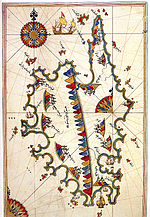Our website is made possible by displaying online advertisements to our visitors.
Please consider supporting us by disabling your ad blocker.
History of Corsica
| History of Corsica |
|---|
 |
|
|


The history of Corsica goes back to antiquity, and was known to Herodotus, who described Phoenician habitation in the 6th century BCE. Etruscans and Carthaginians expelled the Ionian Greeks, and remained until the Romans arrived during the Punic Wars in 237 BCE. Vandals occupied it in 430 CE, followed by the Byzantine Empire a century later.
Raided by various Germanic and other groups for two centuries, it was conquered in 774 by Charlemagne under the Holy Roman Empire, which fought for control against the Saracens. After a period of feudal anarchy, the island was transferred to the papacy, then to city states Pisa and Genoa, which retained control over it for five centuries, until the establishment of the Corsican Republic in 1755. The French gained control in the 1768 Treaty of Versailles. Corsica was briefly independent as a Kingdom in union with Great Britain after the French Revolution in 1789, with a viceroy and elected Parliament, but returned to French rule in 1796.
Corsica strongly supported the allies in World War I, caring for wounded, and housing POWs. The poilus fought loyally and suffered great casualties. A recession after the war prompted a mass exodus to southern France. Wealthy Corsicans became colonizers in Algeria and Indochina.
After the Fall of France in 1940, Corsica was part of the southern zone libre of the Vichy regime. Fascist leader Benito Mussolini agitated for Italian control, supported by Corsican irredentists. In 1942, Italy occupied Corsica with a huge force. German forces took over in 1943 after the Allied armistice with Italy. The Germans faced opposition from the French Resistance, retreating and evacuating the island by October 1943. Corsica then became an Allied air base, supporting the Mediterranean Theater in 1944, and the invasion of southern France in August 1944. Since the war, Corsica has developed a thriving tourism industry, and has been known for its independence movements, sometimes violent.

- ^ Antonetti, Pierre. "The Moor's Head ... A Symbol". Trois Etudes sur Paoli. corseweb. Archived from the original on 16 May 2008. Retrieved 27 May 2008.
Previous Page Next Page


